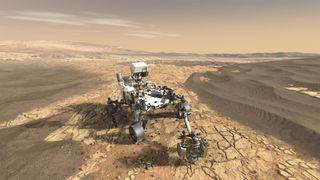
Mars exploration will get a big boost next summer.
Earth and the Red Planet align favorably for interplanetary travel just once every 26 months, for a few weeks at a time. The next such window opens in mid-July 2020, and four big-ticket missions aim to take full advantage.
NASA's car-size Mars 2020 rover is scheduled to lift off on July 17. The European-Russian ExoMars rover, named Rosalind Franklin after the renowned scientist, will follow suit eight days later, if all goes according to plan. Both vehicles will touch down in February 2021, hunt for signs of Martian life and perform a variety of other tasks.
Related: The Search for Life on Mars (A Photo Timeline)
For example, Mars 2020 will cache samples for future return to Earth and demonstrate new tech that generates oxygen from the carbon-dioxide-dominated Martian atmosphere — gear that would be very useful for astronauts exploring the Red Planet.
Mars 2020 will also tote a tiny helicopter scout, potentially laying the foundation for extensive aerial Red Planet exploration down the road.
China also aims to hit the mid-2020 launch window with its Mars Global Remote Sensing Orbiter and Small Rover mission, also known as HX-1. As the name suggests, this effort will include both an orbiter and a rover, which between them will carry 13 science instruments, SpaceNews reported in May.
Get the Space.com Newsletter
Breaking space news, the latest updates on rocket launches, skywatching events and more!
The solar-powered rover will weigh 530 lbs. (240 kilograms), according to SpaceNews. That's about twice as much as China's Yutu moon rovers, two of which have landed on the moon — in December 2013 and January 2019, on the Chang'e 3 and Chang'e 4 missions, respectively. (Chang'e 4 pulled off the first-ever soft touchdown on the moon's mysterious far side.)
HX-1 will be China's second attempt at a Mars mission. The nation's Yinghuo-1 orbiter rode piggyback with Russia's Phobos-Grunt sample-return mission, which launched in November 2011. But Phobos-Grunt never made it out of Earth orbit, and that spacecraft and Yinghuo-1 died fiery deaths in our planet's atmosphere in January 2012.
The fourth 2020 mission comes courtesy of another Mars debutante, the United Arab Emirates. The UAE's Hope Mars Mission, also known as the Emirates Mars Mission, will lift off from Japan atop an H-IIA rocket and get to the Red Planet in early 2021 — the year the UAE turns 50.
The mission "aims to collect information on Mars' meteorological layers and study the causes of loss of hydrogen and oxygen gases, the two main constituents of water, from the upper layer of the Martian atmosphere," the UAE's Gulf News reported Tuesday (July 24).
These newcomers will push Mars' robotic population into the double digits. There are currently two operational craft on the Martian surface (NASA's Curiosity rover and InSight lander) and six orbiters circling the planet (NASA's MAVEN, Mars Odyssey and Mars Reconnaissance Orbiter; Europe's Mars Express and the European-Russian ExoMars Trace Gas Orbiter; and India's Mars Orbiter Mission).
- Occupy Mars: History of Robotic Red Planet Missions (Infographic)
- NASA's Mars Rover 2020 Mission in Pictures (Gallery)
- ExoMars: Searching for Life on Mars
Editor's note: This story originally identified Mars InSight as both an orbiter and a lander. Mars Odyssey is the other orbiter at the Red Planet; the story has been corrected to clarify that.
Mike Wall's book about the search for alien life, "Out There" (Grand Central Publishing, 2018; illustrated by Karl Tate), is out now. Follow him on Twitter @michaeldwall. Follow us on Twitter @Spacedotcom or Facebook.
Join our Space Forums to keep talking space on the latest missions, night sky and more! And if you have a news tip, correction or comment, let us know at: community@space.com.

Michael Wall is a Senior Space Writer with Space.com and joined the team in 2010. He primarily covers exoplanets, spaceflight and military space, but has been known to dabble in the space art beat. His book about the search for alien life, "Out There," was published on Nov. 13, 2018. Before becoming a science writer, Michael worked as a herpetologist and wildlife biologist. He has a Ph.D. in evolutionary biology from the University of Sydney, Australia, a bachelor's degree from the University of Arizona, and a graduate certificate in science writing from the University of California, Santa Cruz. To find out what his latest project is, you can follow Michael on Twitter.
Most Popular


